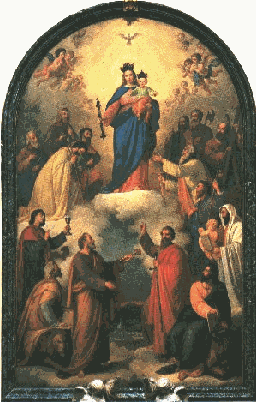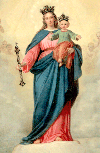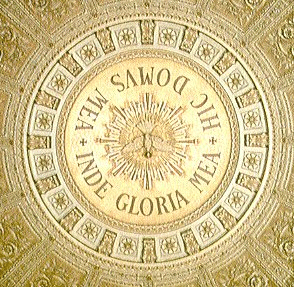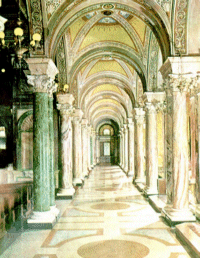
|
Finally on
9th June, 1868, the solemn consecration took place.
These were intensely moving moments for everybody.
The dream had come true. The "marvellous high church"
stood before the eyes of all, risen as if by a miracle.
Don Bosco took no credit, saying:
"I am
not responsible for the great things that you can see, It is
the Lord and the Most Holy Mary who have deigned to help a poor
priest carry out this work. I have contributed nothing. Aedificavit
sibi domum Maria. Mary herself has built her own house. Every
stone, every ornament marks a grace".
With the sanctuary
built, Don Bosco increased his work in spreading devotion to
the Madonna Ausiliatrice throughout the world, with the title
of Help of Christians. |
The painting
was conceived by Don Bosco who spoke of it to the painter Lorenzone
as a spectacle already seen. "The Most Holy Mary in high
among the choruses of angels. Then the choruses of prophets,
virgins and confessors. On the ground, the emblems of Mary's
great victories and the peoples of the world raising their hands
towards her asking for help".
The painter made
him see that painting such a picture would need a square and
a church as large as Piazza Castello to house it. Don Bosco resigned
himself to reducing the scale of his project.
Lorenzone hired the highest hall in Palazzo Madama and started
work. After three years, the great painting was hung in its place.
Don Bosco
described it
thus:
"The
Virgin standing out in a sea of light and majesty, surrounded
by a horde of angels paying homage as if to their queen. With
her right hand, she holds the sceptre, the symbol of her power,
and with the left, the child with its arms open wide, offering
its grace and mercy to those appealing to the majesty of his
mother. Around and below them are the Apostles and the Evangelists
in a state of sweet ecstasy, almost exclaiming: 'Regina Apostolorum,
ora pro nobis', they contemplate the Holy Virgin in amazement.
At the bottom of the picture, there is the city of Turin with
the sanctuary of Valdocco in close up and with Superga in the
background. The picture's greatest value is the religious ideal
that makes a pious impression on whoever admires it".
|
According to Don Bosco's description, the painting is an effective
portrayal of the title: "Mary, Mother of the Church", and a great page in
Marian catechesis. Mary, being Mother of the Son of God, is the
queen of heaven and earth - the whole Church, represented by
the Apostles and saints, acclaims her Mother and powerful Help
of Christians. |
|
|
THE TITLE OF MARY
HELP OF CHRISTIANS |
In 1862, Don
Bosco said to Fr. Cagliero:
"Our
Lady wants us to honour her with the title of Mary Help of Christians.
The times are so sad that we need the Holy Virgin to help us
preserve and defend the Christian faith".
|
The
title itself was not new to the Church. Since 1500 it was present among the
Loreto litanies; devotion to Mary Help of Christians was already
known during the period of St Pius V. Since 1684, there was a
sort of archconfraternity of Mary Help of Christians in Munich
in Bavaria. Pope Pius VII, initiated the celebration of Mary
Help of Christians, fixing the date as 24th May, the day of his
return to Rome after liberation from Napoleonic imprisonment
in 1814.
In 1868, Don
Bosco wrote:
"The experience of eighteen
centuries has made us see that the Virgin Mary has continued,
in the heavens and with the greatest success, the mission that
the Mother of the Church and Help of Christians began on earth".
|
In 1934 (the same year
as Don Bosco's canonisation) work began on enlarging and embellishing
the Shrine. This was needed on account of the increased population
in the Valdocco area of Turin (pastoral and civic needs), the lack of sufficient exits
from the Church when many of the faithful took part in major
 celebrations (safety reasons),
and there was a desire to
celebrations (safety reasons),
and there was a desire to provide a worthy altar to Don Bosco, who had been declared a
Saint (the
spiritual and Salesian reason).
provide a worthy altar to Don Bosco, who had been declared a
Saint (the
spiritual and Salesian reason).
The extension of the Shrine was designed and executed by the
architects Mario Ceradini and the Salesian Brother Giulio Valotti.
The main additions
were:
- the new altar to St John
Bosco
- the enlarging of the sanctuary with room behind the main altar,
which was also renewed
- the second cupola, 12 metres in diameter, with the Latin inscription:
|
"HIC DOMUS
MEA INDE GLORIA MEA" |
- the two side chapels
and their galleries (the one on the left-hand side for the huge
organ, the largest church organ in Piedmont). The two galleries are linked by a corridor with some
small altars dedicated to the Crucified Christ and various saints
(St Joseph Cottolengo, St Joseph Cafasso, who was Don Bosco's
spiritual director, St Pius V…).
Decoration
of the whole Church was entrusted to the artist Cussetti.


| HOME PAGE | BASILICA
| SAN GIOVANNI BOSCO | CAPPELLA
PINARDI | S. FRANCESCO DI SALES
| CAMERETTE | A.D.M.A.
| RIVISTA M. A. | C.
S. D. M.
| INFO
VALDOCCO
VISIT Nr. 